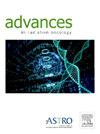Association of Histologic Subtype With Radiation Response and Survival Outcomes in Synovial Sarcoma
IF 2.7
Q3 ONCOLOGY
引用次数: 0
Abstract
Purpose
Synovial sarcoma (SS) is a rare, aggressive soft tissue malignancy that is divided into biphasic and monophasic histologic subtypes. In addition to surgical resection, radiation therapy (RT) improves local control in patients at higher risk of recurrence. This study aimed to investigate the impact of histologic subtype on radiation response and survival outcomes in patients treated with RT as part of definitive management.
Methods and Materials
We retrospectively identified patients with SS treated with RT and surgical resection from 1997 to 2020 at Stanford Medical Center. We assessed the association between histologic subtypes (biphasic vs monophasic) and response to preoperative RT based on imaging and pathology. Volumetric response was calculated using the pre-RT and post-RT/preoperative postcontrast T1-weighted magnetic resonance imaging images. Progression-free survival (PFS) and overall survival (OS) were estimated using the Kaplan-Meier method. Univariable and multivariable analyses were conducted using Cox regression models. Variables for univariable and multivariable analyses included age, histologic subtypes, tumor location, tumor size, margin status, chemotherapy, and performance status.
Results
In our study, 50 patients met the inclusion criteria. The median age was 34.8 years at diagnosis, and 36% (n = 18) received concurrent chemotherapy. Biphasic (n = 18, 36%) and monophasic (n = 32, 64%) tumors exhibited significant differences in negative margin status (94% vs 66%, P = .036). Of the 22 patients who underwent preoperative RT, 15 patients had pre-RT and post-RT imaging to assess volumetric changes. Biphasic tumors demonstrated less necrosis at the time of surgical resection but a significantly greater volumetric decrease with preoperative RT (42% vs 5%, P = .004). PFS and OS were superior in biphasic tumors (P = .003 and P = .009, respectively). Multivariable analyses identified histologic subtypes (monophasic vs biphasic) as a significant factor impacting PFS (HR, 5.65; 95% CI, 1.78-17.91; P = .003).
Conclusions
Biphasic tumors exhibit an improved volumetric response to preoperative RT and improved outcomes. These findings underscore the importance of considering histology when tailoring treatment for patients with SS.
滑膜肉瘤的组织学亚型与放射反应和生存结果的关系
摘要滑膜肉瘤(SS)是一种罕见的侵袭性软组织恶性肿瘤,可分为双相和单相组织学亚型。除了手术切除外,放射治疗(RT)可以改善复发风险较高的患者的局部控制。本研究旨在探讨组织学亚型对放射治疗患者放射反应和生存结果的影响,作为最终治疗的一部分。方法和材料我们回顾性分析1997年至2020年在斯坦福医学中心接受放疗和手术切除治疗的SS患者。我们根据影像学和病理学评估了组织学亚型(双相与单相)与术前放疗反应之间的关系。使用放疗前和放疗后/术前对比后t1加权磁共振成像图像计算体积响应。使用Kaplan-Meier法估计无进展生存期(PFS)和总生存期(OS)。采用Cox回归模型进行单变量和多变量分析。单变量和多变量分析的变量包括年龄、组织学亚型、肿瘤位置、肿瘤大小、边缘状态、化疗和运动状态。结果50例患者符合纳入标准。确诊时的中位年龄为34.8岁,36% (n = 18)患者接受了同期化疗。双相(n = 18, 36%)和单相(n = 32, 64%)肿瘤在切缘阴性状态上存在显著差异(94% vs 66%, P = 0.036)。在接受术前放疗的22例患者中,15例患者接受了放疗前和放疗后的影像学检查以评估体积变化。双相肿瘤在手术切除时坏死较少,但术前放疗时体积下降明显更大(42% vs 5%, P = 0.004)。PFS和OS在双期肿瘤中较优(P = 0.003和P = 0.009)。多变量分析确定组织学亚型(单相vs双相)是影响PFS的重要因素(HR, 5.65;95% ci, 1.78-17.91;P = .003)。结论双期肿瘤对术前放疗的体积反应改善,预后改善。这些发现强调了在为SS患者量身定制治疗时考虑组织学的重要性。
本文章由计算机程序翻译,如有差异,请以英文原文为准。
求助全文
约1分钟内获得全文
求助全文
来源期刊

Advances in Radiation Oncology
Medicine-Radiology, Nuclear Medicine and Imaging
CiteScore
4.60
自引率
4.30%
发文量
208
审稿时长
98 days
期刊介绍:
The purpose of Advances is to provide information for clinicians who use radiation therapy by publishing: Clinical trial reports and reanalyses. Basic science original reports. Manuscripts examining health services research, comparative and cost effectiveness research, and systematic reviews. Case reports documenting unusual problems and solutions. High quality multi and single institutional series, as well as other novel retrospective hypothesis generating series. Timely critical reviews on important topics in radiation oncology, such as side effects. Articles reporting the natural history of disease and patterns of failure, particularly as they relate to treatment volume delineation. Articles on safety and quality in radiation therapy. Essays on clinical experience. Articles on practice transformation in radiation oncology, in particular: Aspects of health policy that may impact the future practice of radiation oncology. How information technology, such as data analytics and systems innovations, will change radiation oncology practice. Articles on imaging as they relate to radiation therapy treatment.
 求助内容:
求助内容: 应助结果提醒方式:
应助结果提醒方式:


